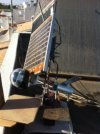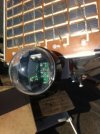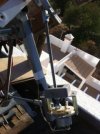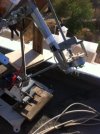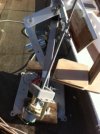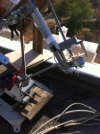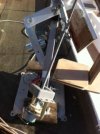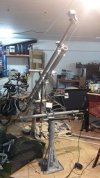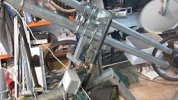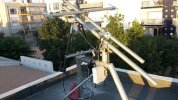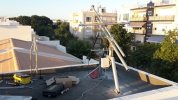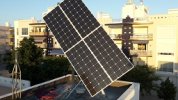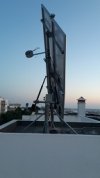I am lucky enough to live in a pleasant climate and for a number of years I have toyed with installing PV (electric) solar panels.
There used to be a sell-back system here, but the few licences were quickly handed out to friends & families of the issuing entity, as is the way here. (Not complaining, it was like this long before I got here and I accept as-is!).
However, it still makes sense I think to generate power for ones own use. By using that, it should slow down or stop the electricity meter thus reducing the bill.
To have a system installed professionally would never make economic sense. The many snouts in the trough would push the cost up to the point where it would never pay for itself. But reasonably priced systems can be bought and, with some DIY skills should be a doddle to install.
So I have some available roof space (will have more soon once I re-locate the various satellite dishes dotted about the place) with good clear views to the south. (This is my neighbour's roof- to the south- nice and un-cluttered- there is more flat area to the left, out of frame).

My first thought was how to align the panels. Due south is the norm of course, but it seems very wasteful, as the early morning and late evening hours would be lost, as solar panels only work well when facing the sun. So this is where the whole project became a bit more complicated.
I decided to make a tracking system. I have installed numerous motorised satellite dishes over the years and decided to adopt a similar system to that of a prime focus (polar mount)dish, only with dual-axis (EL and AZ) control. I also have skip-loads of old (and some unused but redundant) kit lying around, so I will be using as much of that as I can. My thinking is that by having the pivot perpendicular to the sun's arc, the elevation motor would have very little work to do on a daily basis, its only function would be to adjust the elevation seasonally. (A quick calculation with the help of Google reveals that the elevations for 37°N are roughly 30° and 60° for summer and winter respectively).
So the kit I already have to hand: Three satellite dish "jacks"- old Echostar 18" ones that still work well. Designed for 36V but run quite happily on 12V- Numerous 80mm galvanized dish brackets with associated hardware- Boxes and boxes of screws, nuts, washers (I don't throw much away!) and hopefully most of the tools I will need.
Prior to spending a four-figure sum on the panels, inverters etc., I thought it would be an idea to throw together a working model- albeit single-axis. I had a couple of old 5 watt panels powering a bathroom fan, so I made up a rudimentary base (backplate off an old sat dish) and using some threaded dowel and a motor (and gears) robbed from an Airwick room smellifier (PIR already robbed for something else!) all I needed was a control circuit to run the motor to keep the panels facing the sun. I cheated a bit at this point- I had a quick look on the 'Bay to see if I could glean (OK, steal!) some ideas, and found a ready-made unit for less than £20. At that price it hardly seemed worth switching on the soldering iron. It arrived amazingly quickly considering it came from Malaysia (or wherever) and, although it was far from perfect, with a couple of modifications, it soon provided the necessary.
So the baby unit was born and after a couple of teething problems it is now working away, faithfully tracking the sun from about 9am (it takes about an hour to realise that the sun's behind it first thing!) until sun-down. I will post some photo's of it in the next post.
There used to be a sell-back system here, but the few licences were quickly handed out to friends & families of the issuing entity, as is the way here. (Not complaining, it was like this long before I got here and I accept as-is!).
However, it still makes sense I think to generate power for ones own use. By using that, it should slow down or stop the electricity meter thus reducing the bill.
To have a system installed professionally would never make economic sense. The many snouts in the trough would push the cost up to the point where it would never pay for itself. But reasonably priced systems can be bought and, with some DIY skills should be a doddle to install.
So I have some available roof space (will have more soon once I re-locate the various satellite dishes dotted about the place) with good clear views to the south. (This is my neighbour's roof- to the south- nice and un-cluttered- there is more flat area to the left, out of frame).

My first thought was how to align the panels. Due south is the norm of course, but it seems very wasteful, as the early morning and late evening hours would be lost, as solar panels only work well when facing the sun. So this is where the whole project became a bit more complicated.
I decided to make a tracking system. I have installed numerous motorised satellite dishes over the years and decided to adopt a similar system to that of a prime focus (polar mount)dish, only with dual-axis (EL and AZ) control. I also have skip-loads of old (and some unused but redundant) kit lying around, so I will be using as much of that as I can. My thinking is that by having the pivot perpendicular to the sun's arc, the elevation motor would have very little work to do on a daily basis, its only function would be to adjust the elevation seasonally. (A quick calculation with the help of Google reveals that the elevations for 37°N are roughly 30° and 60° for summer and winter respectively).
So the kit I already have to hand: Three satellite dish "jacks"- old Echostar 18" ones that still work well. Designed for 36V but run quite happily on 12V- Numerous 80mm galvanized dish brackets with associated hardware- Boxes and boxes of screws, nuts, washers (I don't throw much away!) and hopefully most of the tools I will need.
Prior to spending a four-figure sum on the panels, inverters etc., I thought it would be an idea to throw together a working model- albeit single-axis. I had a couple of old 5 watt panels powering a bathroom fan, so I made up a rudimentary base (backplate off an old sat dish) and using some threaded dowel and a motor (and gears) robbed from an Airwick room smellifier (PIR already robbed for something else!) all I needed was a control circuit to run the motor to keep the panels facing the sun. I cheated a bit at this point- I had a quick look on the 'Bay to see if I could glean (OK, steal!) some ideas, and found a ready-made unit for less than £20. At that price it hardly seemed worth switching on the soldering iron. It arrived amazingly quickly considering it came from Malaysia (or wherever) and, although it was far from perfect, with a couple of modifications, it soon provided the necessary.
So the baby unit was born and after a couple of teething problems it is now working away, faithfully tracking the sun from about 9am (it takes about an hour to realise that the sun's behind it first thing!) until sun-down. I will post some photo's of it in the next post.
Last edited:

